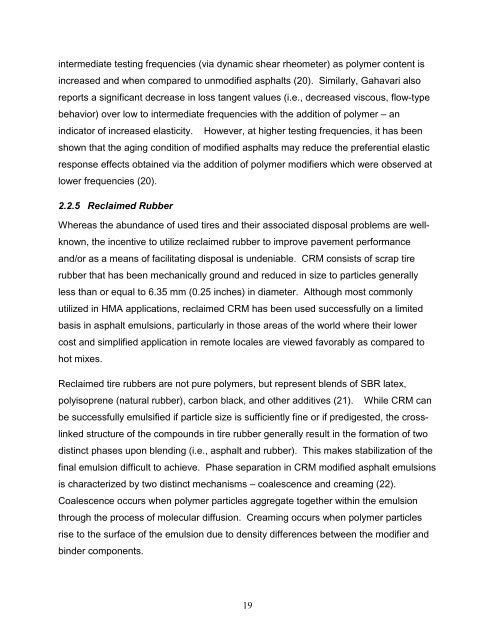Using Polymer Modified Asphalt Emulsions in Surface Treatments A ...
Using Polymer Modified Asphalt Emulsions in Surface Treatments A ...
Using Polymer Modified Asphalt Emulsions in Surface Treatments A ...
Create successful ePaper yourself
Turn your PDF publications into a flip-book with our unique Google optimized e-Paper software.
<strong>in</strong>termediate test<strong>in</strong>g frequencies (via dynamic shear rheometer) as polymer content is<br />
<strong>in</strong>creased and when compared to unmodified asphalts (20). Similarly, Gahavari also<br />
reports a significant decrease <strong>in</strong> loss tangent values (i.e., decreased viscous, flow-type<br />
behavior) over low to <strong>in</strong>termediate frequencies with the addition of polymer – an<br />
<strong>in</strong>dicator of <strong>in</strong>creased elasticity. However, at higher test<strong>in</strong>g frequencies, it has been<br />
shown that the ag<strong>in</strong>g condition of modified asphalts may reduce the preferential elastic<br />
response effects obta<strong>in</strong>ed via the addition of polymer modifiers which were observed at<br />
lower frequencies (20).<br />
2.2.5 Reclaimed Rubber<br />
Whereas the abundance of used tires and their associated disposal problems are wellknown,<br />
the <strong>in</strong>centive to utilize reclaimed rubber to improve pavement performance<br />
and/or as a means of facilitat<strong>in</strong>g disposal is undeniable. CRM consists of scrap tire<br />
rubber that has been mechanically ground and reduced <strong>in</strong> size to particles generally<br />
less than or equal to 6.35 mm (0.25 <strong>in</strong>ches) <strong>in</strong> diameter. Although most commonly<br />
utilized <strong>in</strong> HMA applications, reclaimed CRM has been used successfully on a limited<br />
basis <strong>in</strong> asphalt emulsions, particularly <strong>in</strong> those areas of the world where their lower<br />
cost and simplified application <strong>in</strong> remote locales are viewed favorably as compared to<br />
hot mixes.<br />
Reclaimed tire rubbers are not pure polymers, but represent blends of SBR latex,<br />
polyisoprene (natural rubber), carbon black, and other additives (21). While CRM can<br />
be successfully emulsified if particle size is sufficiently f<strong>in</strong>e or if predigested, the crossl<strong>in</strong>ked<br />
structure of the compounds <strong>in</strong> tire rubber generally result <strong>in</strong> the formation of two<br />
dist<strong>in</strong>ct phases upon blend<strong>in</strong>g (i.e., asphalt and rubber). This makes stabilization of the<br />
f<strong>in</strong>al emulsion difficult to achieve. Phase separation <strong>in</strong> CRM modified asphalt emulsions<br />
is characterized by two dist<strong>in</strong>ct mechanisms – coalescence and cream<strong>in</strong>g (22).<br />
Coalescence occurs when polymer particles aggregate together with<strong>in</strong> the emulsion<br />
through the process of molecular diffusion. Cream<strong>in</strong>g occurs when polymer particles<br />
rise to the surface of the emulsion due to density differences between the modifier and<br />
b<strong>in</strong>der components.<br />
19
















